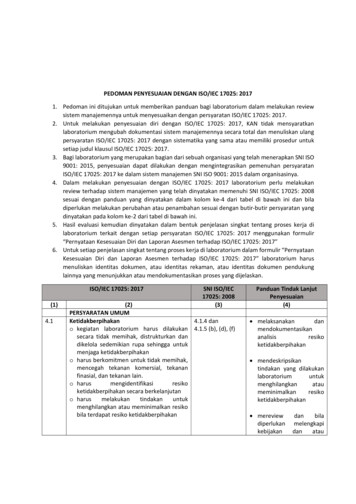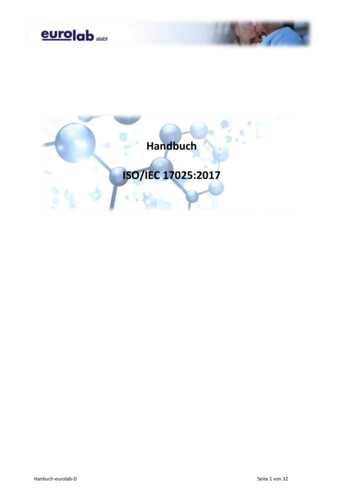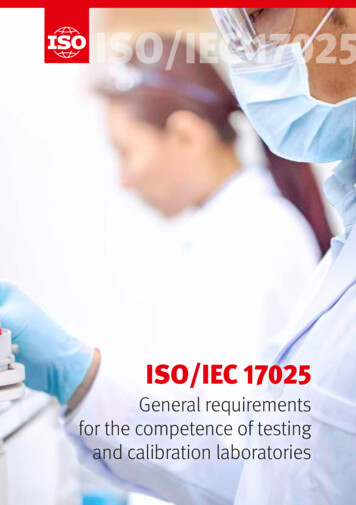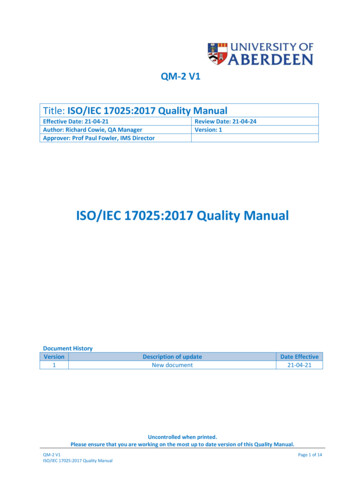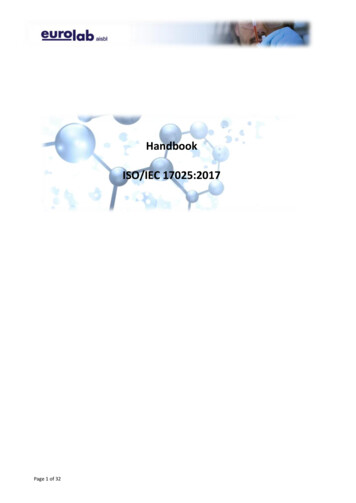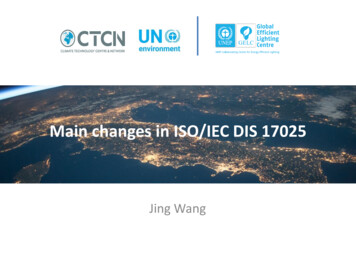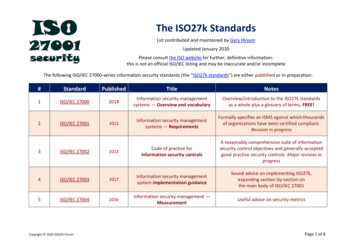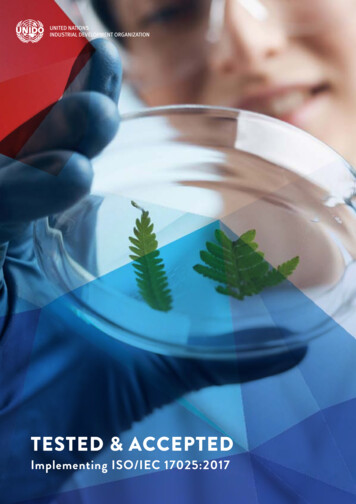
Transcription
TESTED & ACCEPTEDImplementing ISO/IEC 17025:201711
22
TESTED & ACCEPTEDImplementing ISO/IEC 17025:201733
Table of ContentsF O R E W O R D . . . . . . . . . . . . . . . . . . . . . . . . . . . . . . . . . . . . . . . . . . . . . . . . . . . . . . . . . . . . . . . . . . . . . . . . . . . . . . . . . . . . . . . . . . . . . . . . . . . . . . . . . . . . . . . . . . . . . . . . 9P R E F A C E . . . . . . . . . . . . . . . . . . . . . . . . . . . . . . . . . . . . . . . . . . . . . . . . . . . . . . . . . . . . . . . . . . . . . . . . . . . . . . . . . . . . . . . . . . . . . . . . . . . . . . . . . . . . . . . . . . . . . . . . . . 11A B B R E V I AT I O N S . . . . . . . . . . . . . . . . . . . . . . . . . . . . . . . . . . . . . . . . . . . . . . . . . . . . . . . . . . . . . . . . . . . . . . . . . . . . . . . . . . . . . . . . . . . . . . . . . . . . . . . . . . . . . . . . . . . . . . . 12B I B L I O G R A P H Y . . . . . . . . . . . . . . . . . . . . . . . . . . . . . . . . . . . . . . . . . . . . . . . . . . . . . . . . . . . . . . . . . . . . . . . . . . . . . . . . . . . . . . . . . . . . . . . . . . . . . . . . . . . . . . . . . . . . . . . 13T H E U N I T E D N AT I O N S I N D U ST R I A L D E V E LO P M E N T O R G A N I Z AT I O N( U N I D O ) . . . . . . . . . . . . . . . . . . . . . . . . . . . . . . . . . . . . . . . . . . . . . . . . . . . . . . . . . . . . . . . . . . . . . . . . . . . . . . . . . . . . . . . . . . . . . . . . . . . . . . . . . . . . . . . . . . . . . . . . . . . . 14UNIDO’S WORK IN CONFORMITY ASSESSMENT15NEW TECHNOLOGIES CALL FOR CHANGE17. . . . . . . . . . . . . . . . . . . . . . . . . . . . . . . . . . . . . . . . . . . . . . . . . . . . . . . . . . . . . . . . . . . . . . . . . . . . . . . . . . . . . . . . . . . . . . . . . . . . . . . . . . . . . . . . . . . . . . . . . . . . .TOWARDS THE ACHIEVEMENT OF THE SUSTAINABLE DEVELOPMENT GOALS (SDGS). . . . . . . . . . . .181. I N T R O D U C T I O N . . . . . . . . . . . . . . . . . . . . . . . . . . . . . . . . . . . . . . . . . . . . . . . . . . . . . . . . . . . . . . . . . . . . . . . . . . . . . . . . . . . . . . . . . . . . . . . . . . . . . . . . . . . . . . . . . . . . . . . 20HISTORY OF ISO/IEC 17025. . . . . . . . . . . . . . . . . . . . . . . . . . . . . . . . . . . . . . . . . . . . . . . . . . . . . . . . . . . . . . . . . . . . . . . . . . . . . . . . . . . . . . . . . . . . . . . . . . . . . . . . . . . . . . . . . . . . . . . . . . . . . . . . . . . . . . . . . . . . . . . . . . . . . . . . . . . . . . . . . . . .TESTING AND CALIBRATION. . . . . . . . . . . . . . . . . . . . . . . . . . . . . . . . . . . . . . . . . . . . . . . . . . . . . . . . . . . . . . . . . . . . . . . . . . . . . . . . . . . . . . . . . . . . . . . . . . . . . . . . . . . . . . . . . . . . . . . . . . . . . . . . . . . . . . . . . . . . . . . . . . . . . . . . . . . . . . . . . . .21212. T R A D E . . . . . . . . . . . . . . . . . . . . . . . . . . . . . . . . . . . . . . . . . . . . . . . . . . . . . . . . . . . . . . . . . . . . . . . . . . . . . . . . . . . . . . . . . . . . . . . . . . . . . . . . . . . . . . . . . . . . . . . . 1 7SUSTAINABLE DEVELOPMENT GOALS. . . . . . . . . . . . . .WORLD TRADE ORGANISATION AGREEMENTS. . . . . . . . . . . . .2323CONFORMITY ASSESSMENT IN TRADE AGREEMENTS23MARKET SURVEILLANCE23. . . . . . . . . . . . . . . . . . . . . . . . . . . . . . . . . . . . . . . . . . . . . . . . . . . . . . . . . . . . . . . . . . . . . . . . . . . . . . . . . . . . . . . . . . . . . . . . . . . . . . . . . . . . . . . . . . . . . . . . . . . . . . . . . . . . . . . . . . . . . . . . . . .3 . Q UA L I TY I N F R A ST R U C T U R E S YS T E M . . . . . . . . . . . . . . . . . . . . . . . . . . . . . . . . . . . . . . . . . . . . . . . . . . . . . . . . . . . . . . . . . . . . . . . . . . . . . . . . . 24QUALITY POLICY. . . . . . . . . . . . . . . . . . . . . . . . . . . . . . . . . . . . . . . . . . . . . . . . . . . . . . . . . . . . . . . . . .METROLOGY. . . . . . . . . . . . . . . . . . . . . . . . . . . . . . . . . . . . . . . . . . . . . . . . . . . . . . . . . . . . . . . . . . . . . . . . . . . . . . . . . . . . . . . . . . . . . . . . . . . . . . . . . . . . . . . . . . . . . . . . . . . . . . . . . . . . . . . . . . . . . . . . . . . . . . . . . . . . . . . . . . . . . . . . . . . . . . . . . . . . . . . . . . . . . . . . . . . . . . . . .STANDARDISATION. . . . . . . . . . . . . . . . . . . . . . . . . . . . . . . . . . . . . . . . . . . . . . . . . . . . . . . . . . . . . . . . . . . . . . . . . . . . . . . . . . . . . . . . . . . . . . . . . . . . . . . . . . . . . . . . . . . . . . . . . . . . . . . . . . . . . . . . . . . . . . . . . . . . . . . . . . . . . . . . . . . . . . . . . . . . . . . . . . . . . . . .CONFORMITY ASSESSMENT. . . . . . . . . . . . . . . . . . . . . . . . . . . . . . . . . . . . . .25252626
ACCREDITATION. . . . . . . . . . . . . . . . . . . . . . . . . . . . . . . . . . . . . . . . . . . . . . . . . . . . . . . . . . . . . . . . . . . . . . . . . . . . . . . . . . . . . . . . . . . . . . . . . . . . . . . . . . . . . . . . . . . . . . . . . . . . . . . . . . . . . . . . . . . . . . . . . . . . . . . . . . . . . . . . . . . . . . . . . . . . . . . . . . . . . . . . . . . . . . . .ENTERPRISES AND CONSUMERS. . . . . . . . . . . . . . . . . . . . . . . . .26264 . CO N F O R M I TY A SSESSM E N T . . . . . . . . . . . . . . . . . . . . . . . . . . . . . . . . . . . . . . . . . . . . . . . . . . . . . . . . . . . . . . . . . . . . . . . . . . . . . . . . . . . . . . . . . . . . . . . . . . . . . . . . . . . . . 28FUNCTIONAL APPROACH. . . . . . . . . . . . . . . . . . . . . . . . . . . . . . . . . . . . . . . . . . . .29CONFORMITY ASSESSMENT ACTIVITIES29CASCO TOOLBOX29. . . . . . . . . . . . . . . . . . . . . . . . . . . . . . . . . . . . . . . . . . . . . . . . . . . . . . . . . . . . . . . . . . . . . . . . . . . . . . . . . . . . . . . . . . . . . . . . . . . . . . . . . . . . . . . . . . . . . . . . . . . . . . . . . . . . . . . . . . . . . . . . . . . . . . . . . . . . . . . . . . . . . . . . . . . . . . . . . . . . . . . . . . . . . . . . . . . . . . . . . . . . . . . . . . . . . . . . . . . . . . . . . . . . . . . . . . . . . . . . . . . . . . . . . . . . . . . . . . . . . . . . . . . . . . . . . . . . . . . . . . . . . . . . . . . . . . . . . . . . . . . . . . . . . . . . . . . . . . .5 . I S O / I EC 1 702 5 . . . . . . . . . . . . . . . . . . . . . . . . . . . . . . . . . . . . . . . . . . . . . . . . . . . . . . . . . . . . . . . . . . . . . . . . . . . . . . . . . . . . . . . . . . . . . . . . . . . . . . . . . . . . . . . . . . . . . . . . . 32SUMMARY OF FUNDAMENTAL CHANGES WITH REVISED VERSION 2017. . . . . . . . . . .EXPLANATION OF CHANGES AND CONSEQUENCES, GUIDANCE TO APPLICATIONINTRODUCTION. . . . . . . . . . . . . . . . . . . . . . . . . . . . . . . . . . . . . . . . . . . . . . . . . . . . . . . . . . . . . . . . . . . . . . . . . . . . . . . . . . . . . . . . . . . . . . . . . . . . . . . . . . . . . . . . . . . . . . . . . . . . . . . . . . . . . . . . . . . . . . . . . . . . . . . . . . . . . . . . . . . . . . . . . . . . . . . . . . . . . . . . . . . . . . . . . . . . . . . . . . . . .S CO P E ( C L AU S E 1). . . . . . . . . . . . . . . . . . . . . . . . . . . . . . . . . . . . . . . . . . . . . . . . . . . . . .R E F E R E N CES ( C L A U SE 2). . . . . . . . . . . . . . . . . . . . . . . . . . . . . . . . . . . . . . . .T E R MS & D E F I N I T I O N S ( C L A U SE 3)I M PA RT I A L I TY ( C L A U SE 4.1). . . . . . . . . . . . . . . . . . . . . . . . . . . . . . . . .CO N F I D E N T I A L I TY ( C L A U SE 4.2)ST R U C T U R E ( C L A U SE 5). . . . . . . . . . . . . . . . . . . . . . . . . . . . . . . . . . . . . . . . . . . . . . . . . . . . . . . . . . . . . . . . .R ES O U R CES ( C L A U SE 6)P R O C ESS ( C L AU S E 7). . . . . . . . . . . . . . . . . . . . . . . . . . . . . . . . . . . . . . . . . . . . . . . . . . . . . . . . . . . . . . . . . . . . . . . . . . . . . . . . . . . . . . . . . . . . . . . . . . . . . . . . . . . . . . . . . . . . . . . . . . . . . . . . . . . . . . . . . . . . . . . . . . . . . . . . . . . . . . . . . . . . . . . . . . . . . . . . . . . . . . . . . . . . . . . . . . . . . . . . . . . . . . . . . . . . . . . . . . . . . . . . . . . . . . . . . . . . . . . . . . . . . . . . . . . . . . . . . . . . . . . . . . . . . . . . . . . . . . . . . . . . . . . . . . . . . . . . . . . . . . . . . . . . . . . . . . . . . . . . . . . . . . . . . . . . . . . . . . . . . . . . . . . . . . . . . . . . . . . . . . . . . . . . . . . . .M A N A G E M E N T SYST E M ( C L A U SE 8). . . . . . . . . . . . . . . . . . . . . . . . . . . . . . . . . . . . . . . . . . . . . . . . . . . . . . . . . . . . . . . . . . . . . . . . . . . . . . . . . . . . . . . . . . . . . . . . . . . . . . . . . . . . . . . . . . . . . . . . . . . . . . . . . . . . . . . . . . . . . . . . . . . . . . .333535353536363738404757ANNEX AC R O SS - R E F E R E N CES I S O / I EC 1 702 5 2 01 7 – 2 005 . . . . . . . . . . . . . . . . . . . . . . . . . . . . . . . . . . . . . . . . . . . . . . 66
66
ACKNOWLEDGEMENTSThis guidebook on ISO/IEC 17025 (2017) is publishedby the United Nations Industrial DevelopmentOrganisation (UNIDO), under the overall guidance ofMr. Bernardo Calzadilla-Sarmiento, Managing Directorof the Directorate of Digitalization, Technology andAgri-Business. Technical inputs were coordinated byMs. Dorina Nati, Programme Coordinator of the GlobalQuality and Standards Programme (GQSP).The document was written by Dr. Stefanie Vehringbased on the previous UNIDO issue “Complying withISO 17025” (2009) by Dr. Alan G Rowley. Dr. Vehringparticipated in the Working Group on the latest revisionof ISO/IEC 17025 (2017) and, since then, has beeninvolved in training on the new version for variousaudiences.UNIDO acknowledges the valuable contribution of Mr.Peter Unger, and the comments received by Mr. BrahimHoula and Mr. Shaukat Hussain.This publication was developed under the GlobalQuality and Standards Programme (GQSP), funded bySwitzerland, through its State Secretariat of EconomicAffairs (SECO).DISCLAIMERCopyright 2020 United Nations Industrial DevelopmentOrganization. This document has been produced without formalUnited Nations editing. The designations and the presentation ofthe material in this document do not imply the expression of anyopinion whatsoever on the part of the Secretariat of the UnitedNations Industrial Development Organization (UNIDO). Mention ofcompany names or commercial products does not constitute anendorsement by UNIDO. Although great care has been taken tomaintain the accuracy of the information presented, neither UNIDOnor its member states assume any responsibility for consequenceswhich may arise from the use of the material. This document maybe freely quoted or reprinted, but acknowledgement is requested.
ForewordDeveloping countries are constantly striving toenhance their export competitiveness, strengthentheir export base and become more integrated withinternational trade flows. To achieve this, they need tobe able to access increasingly complex global marketswith rigorous quality standards. In order to “make thegrade” in exporting to these competitive markets, itis necessary to demonstrate compliance with globalquality infrastructure (QI) markers: standardizationto achieve compliance with international standards;metrology services to demonstrate accuratemeasurements; certification and accreditation toprove that goods and services have been testedaccording to agreed methods. Convenient and costeffective conformity assessment services are alsovital to demonstrate that products have been tested,inspected and certified prior to entering the market.This publication provides practical guidance to ISO/IEC17025, the international standard for the competenceof testing and calibration laboratories. It is intendedto aid laboratories to conform to the ISO/IEC 17025requirements as well as when they transition to therevised 2017 standard.Today it is widely acknowledged that a first step infacilitating acceptance of foreign-generated test resultshappens through accreditation, using an agreedset of general criteria for the competence of testinglaboratories. Without consensus on accreditation, it isimpossible to generate the cross-border confidence inproduct standards necessary to enable internationaltrade.The bedrock of our current international accreditationregime dates back to 1978, at the Second Conferenceon Facilitating Cross-border Acceptance of Test Results,which became known as the International LaboratoryAccreditation Conference (ILAC) (later changed to aCooperation in 1996 through the establishment ofa network of mutual recognition agreements amongaccreditation bodies). A small group of nationalaccreditation body leaders developed the first draft,which was presented to the International Organizationfor Standardization (ISO) for adoption as the ISO Guide25. This formed the basis for the founding of ISO/IEC17025.Up to the present day, ISO/IEC 17025 enableslaboratories to demonstrate that they operatecompetently, to an agreed framework, generating validresults, thereby promoting confidence in their workboth nationally and around the world. ISO/IEC 1702588
helps facilitate cooperation between laboratories andother bodies by generating wider acceptance of testresults between countries. Test reports and certificatesare accepted by one country to another without theneed for further testing, which, in turn, accelerates andimproves confidence in international trade.The ISO Guide 25 was initially used to underpinbilateral mutual recognition arrangements (MRAs)between accreditation bodies. MRA signatories agreeto accept each other’s accreditations as equivalentand to promote acceptance of accredited results withintheir economies. In November 2000, ILAC convertedthe numerous bilateral and two regional multilateralarrangements into a global multilateral mutualrecognition arrangement signed by 36 accreditationbodies from 28 economies, simplifying and enhancingthe international acceptance of accreditation regimessignificantly. The aim was to facilitate trade bypromoting the acceptance of accredited test andcalibration results for exported goods. The ILAC MutualRecognition Arrangement (often referred to as theILAC Arrangement) was the culmination of 22 yearsof intensive work aimed at establishing a multilateralregime in the field of laboratory policy. ISO/IEC 17025is the foundation of that arrangement.As the largest multilateral player in qualityinfrastructure development, with a proven trackrecord of enhancing national capacities, the UnitedNations Industrial Development Organization (UNIDO)is the preferred partner of many developed countries(as donors) and developing countries (as recipientsof international technical assistance) for ensuringthat quality infrastructure specifications are met ona worldwide basis. Policymakers and practitionersturn to UNIDO for their transformative and tailoredsolutions, from specialized training to the transfer oftechnical knowledge.For more than 50 years since its establishment,UNIDO has been supporting developing countriesand countries in transition in the development oftheir quality infrastructure, through the setting upof National Standards Bodies (NSB) and NationalMetrology Institutes (NMI), and during the last twodecades, the establishment of Accreditation Bodies(AB). During this time, UNIDO also has supportedmore than 1,000 Conformity Assessment Bodies (CABs)in 58 countries across the different regions in theworld, helping developing countries to increase theirproductive capacities, export bases and, domesticand foreign investment. UNIDO helps laboratoriescommitted to conform to ISO/IEC 17025, enablingthem to reap tangible benefits for their operation anddelivery of results. This supports effective decisionmaking be it for assuring product quality, protectingthe health of consumers, ensuring safety, or promotingsustainability and protection of the environment.UNIDO has been a partner of ILAC since its establishmentand collaborates closely with ISO and its Committee onConformity Assessment (CASCO). Today, UNIDO, ILACand ISO are all members of the International Networkon Quality Infrastructure (INetQI), an initiative thatbrings together the specialized quality infrastructureorganizations operating at international level and thatare active in promoting and implementing qualityinfrastructure activities (metrology, accreditation,standardization and conformity assessment) as a toolfor sustainable economic development.It is evident that establishing reliable qualityinfrastructure can substantially assist a country inpursuing a development path aligned with the SDGs,overcoming the challenges involved, and benefittingfrom the considerable opportunities generatedthrough the achievement of the 2030 Agenda. Withouta rigorous quality infrastructure domestic regime, adeveloping country will find it difficult to achievethe competitiveness needed to propel inclusive andsustainable industrialization (as embedded in SDGGoal 9) in particular.As a leader in the field of quality infrastructure, UNIDOwill have a big role to play in shaping the future ofconformity assessment globally. By aligning itsapproach for quality infrastructure development andtechnical support to the demands of the digital era, itcan ensure that it continues to provide a diversified andeffective programmatic suite of technical cooperation,policy analysis and advice, and convening services forthe benefit of its member states.Li YongUNIDO Director General99
Preface1010
Over the past 20 years, the United Nations IndustrialDevelopment Organization (UNIDO) has been thelargest multilateral player in quality infrastructuredevelopment and a preferred partner of manydeveloped (as donors) and developing countries(recipients of international technical assistance).It has a proven record of enhancing the nationalcapabilities for standardization, metrology, conformityassessment, accreditation and market surveillance,allowing developing countries to increase theirproductive capacity, export base and domestic andforeign investment.This publication is written as a guidance to ISO/IEC 17025, the international standard that specifiesthe general requirements for competence, impartialityand consistent operation of testing and calibrationlaboratories. It is intended to aid laboratories whenestablishing and maintaining ISO/IEC 17025 as wellas when transitioning the implemented standard tothe revised version of 2017.Conformity with ISO/IEC 17025 provides a globallyaccepted basis for recognition of laboratories bycustomers, regulatory authorities, organisations andschemes using peer-assessment, accreditation bodiesand others.The standard specifies the technical requirementsfor competent laboratories. Requirements in order toensure impartiality with regard to the outcome of thelaboratory activities, e.g. testing a sample or calibratingan item, are of particular importance. Finally, ISO/IEC 17025 contains system requirements for managingconsistent operation of laboratory activities.It follows the structure of the standard and providesclause by clause a description of the requirementsalong with further clarification and advice on thedemonstration of fulfilment.The guidance begins with key topics of each clause andthe relation to corresponding requirements accordingto former ISO/IEC 17025 version of 2005.Fundamental changes with the revised version of 2017are summarised ahead of Chapter 5. Detailed crossreferences between the two versions of ISO/IEC 17025are given in Annex A.Laboratories seeking accreditation by a recognisedaccreditation body will find the relevant documents ofthe International Laboratory Accreditation Cooperation(ILAC) indicated, where applicable, and referenced inthe Bibliography. Also listed there are publicationswith basic references for ISO/IEC 17025, such asterminology documents or the management systemstandard ISO 9001, as well as further specifications,such as uncertainty of measurements, referencematerials or management system audits.An overview on the history and role of testing andcalibration is given in Chapter 1.Chapters 2 to 4 contain background information ontrade (UN Sustainable Development Goals, World TradeOrganisation, trade agreements), quality infrastructure(metrology, standardisation, conformity assessment,accreditation) and conformity assessment (testing,inspection, certification, validation, verification).This Guidebook should assist laboratories inidentifying where they fulfil the requirements of ISO/IEC 17025 and in taking measures where fulfilment hasyet to be achieved.1111
Abbreviations1212BIPMBureau International des Poids et MesuresCASCOCommittee on Conformity AssessmentCETAComprehensive Economic and Trade AgreementCRMCertified Reference MaterialECEuropean CommissionEUEuropean UnionIAFInternational Accreditation ForumIECInternational Electrotechnical CommissionILACInternational Laboratory Accreditation CooperationISOInternational Standardisation OrganisationITInformation technologyLIMSLaboratory information management systemMLAMultilateral Recognition ArrangementMRAMutual Recognition ArrangementOIMLOrganisation Internationale de Métrologie LégaleQIQuality InfrastructureQPQuality PolicySDGSustainable Development GoalsSISystème International d’unitésSOPStandard operating procedureSPSSanitary and Phytosanitary MeasuresTBTTechnical Barriers to TradeTFTrade FacilitationUNUnited NationsUNIDOUnited Nations Industrial DevelopmentVIMInternational Vocabulary of MetrologyWTOWorld Trade Organisation
BibliographyBrochures and GuidesUNIDO – Quality Policy – Guiding Principles (2018)ISO 17034 – General requirements for the competenceof reference material producersISO UNIDO – Building Trust – The Conformity AssessmentToolbox (2010)ISO 10012 – Measurement management systems –Requirements for measurement processes andmeasuring equipmentISO UNIDO – Fast Forward – National Standards Bodiesin Developing Countries (2013)ISO Guide 33 – Reference materials – Good practice inusing reference materialsISO – Contributing to the UN Sustainable DevelopmentGoals with ISO standards (2018)ISO Guide 80 – Guidance for the in-house preparationof quality control materials (QCMs)BIPM – SI Brochure – The International System of Units(2019)ISO 19011 – Guidelines for auditing managementsystemsEURACHEM Guide – The Fitness for Purpose of AnalyticalMethods (2014)ISO/IEC Guide 98-3 – Uncertainty of measurement– Part 3: Guide to the expression of uncertainty inmeasurement (GUM:1995)EURACHEM Guide – Quantifying Uncertainty inAnalytical Measurement rgISO/IEC Guide 98-4 – Uncertainty of measurement –Part 4: Role of measurement uncertainty inconformity assessmentIEC Guide 115 – Application of uncertainty ofmeasurement to conformity assessment activities intheelectrotechnical sectorJCGM 106 – Evaluation of measurement data – The roleof measurement uncertainty in conformityassessmentISO 21748 – Guidance for the use of repeatability, reproducibility and trueness estimates inmeasurement uncertainty evaluationISO 5725 ff. – Accuracy (trueness and precision)of measurement methods and resultsAccreditation documentsStandardsILAC G8 – Guidelines on decision rules and statementsof conformityISO/IEC 17025 – General requirements for thecompetence of testing and calibration laboratoriesILAC G17 – Introducing the concept of uncertaintyof measurement in testing in association with theapplication of the standard ISO/IEC 17025ISO/IEC 17000 – Conformity assessment – Vocabularyand general principlesISO/IEC Guide 99 (VIM) – International vocabulary ofmetrology – Basic and general concepts andassociated terms (also known as JCGM 200)ILAC G18 – Guideline for the formulation of scopes ofaccreditation for laboratoriesILAC G24 – Guidelines for the determination ofcalibration intervals of measuring instrumentsISO 9000 – Quality management systems –Fundamentals and vocabularyILAC P9 – ILAC policy for participation in proficiencytesting activitiesQS-CAS-PROC-33 – Common elements in ISO/CASCOstandardsILAC P10 – ILAC policy on traceability of measurementresultsISO 9001 – Quality management systems –RequirementsILAC P14 – ILAC policy for uncertainty in calibrationISO 15189 – Medical laboratories – Requirements forquality and competenceISO/IEC 17043 – Conformity assessment – Generalrequirements for proficiency testing1313
T h e U n i te d N a ti o ns IndustrialDe ve l op m e n t Organi zati o n(U N I D O)1414
THE UNITED NATIONS INDUSTRIALDEVELOPMENT ORGANIZATION (UNIDO)The United Nations Industrial DevelopmentOrganization (UNIDO) helps developing countries andcountries with economies in transition to develop aninclusive, competitive and environmentally sustainableindustry to accelerate economic growth, reducepoverty and achieve the United Nations SustainableDevelopment Goals (SDGs). UNIDO’s mandate is fullyrecognized in SDG-9, which calls to “Build resilientinfrastructure, promote inclusive and sustainableindustrialization and foster innovation”.UNIDO has a proven track record in developingquality infrastructure (QI) that acts as a multiplier forthe efforts of developing countries to improve theirindustrial and economic performance as a basis forprosperity, health and wellbeing. The benefits ofstandardization in improving economic efficiency andproviding access to world markets cannot be achievedwithout the ability to make reliable measurements andto be able to demonstrate that items conform to therequirements specified in the standards.QUALITY INFRASTRUCTURE (QI) is the systemcomprising the organizations (public and private)together with the policies, relevant legal andregulatory framework, and practices neededto support and enhance the quality, safety andenvironmental soundness of goods, servicesand processes. The quality infrastructure isrequired for the effective operation of domesticmarkets, and its international recognition isimportant to enable access to foreign markets. Itis a critical element in promoting and sustainingeconomic development, as well as environmentaland social wellbeing. It relies on metrology,standardization, accreditation, conformityassessment, and market surveillance.In pursuit of these objectives, UNIDO draws on globalresources and expertise, and combines operationaltechnical cooperation services with analytical,normative and convening activities, globally, regionallyand locally.UNIDO holds a special place in the United Nationssystem as the only organization with a mandate topromote industrial development worldwide. TheOrganization focuses on four inter-related thematicpriorities:»»Creating shared prosperity»»Advancing economic competitiveness»»Safeguarding the environment»»Strengthening knowledge and institutionsIn carrying out its mandate, UNIDO has considerablyincreased its portfolio of technical services overthe past ten years. At the same time, it has alsosubstantially increased its mobilization of financialresources, testifying to the growing internationalrecognition of the Organization as an effective providerof industrial development services.UNIDO has 170 Member States and is headquarteredin Vienna, Austria, but operates worldwide, through itsnetwork of country and regional offices. Establishedin 1966, it became a specialized agency of the UnitedNations in 1985.UNIDO’s work in conformity assessmentThe
to former ISO/IEC 17025 version of 2005. Fundamental changes with the revised version of 2017 are summarised ahead of Chapter 5. Detailed cross-references between the two versions of ISO/IEC 17025 are given in Annex A. Laboratories seeking accreditation by a recognised accreditation body will find the relevant documents of
